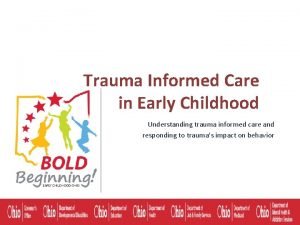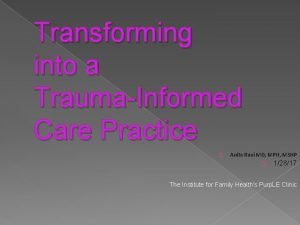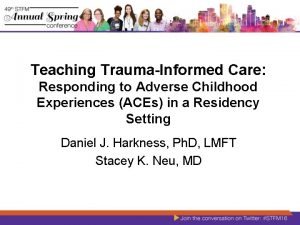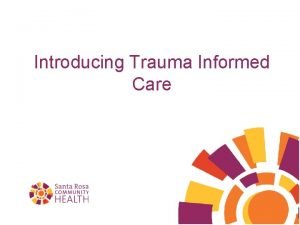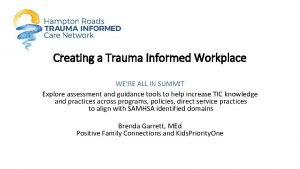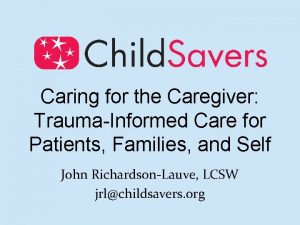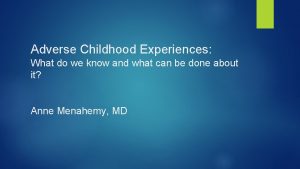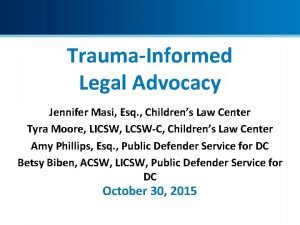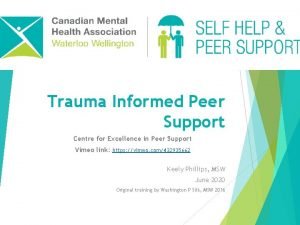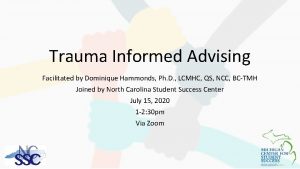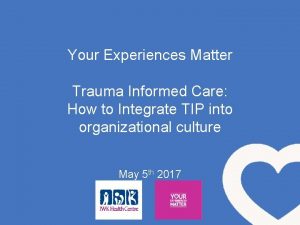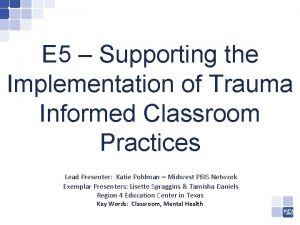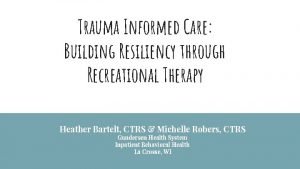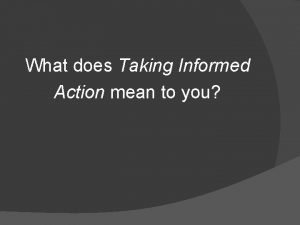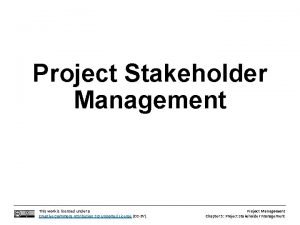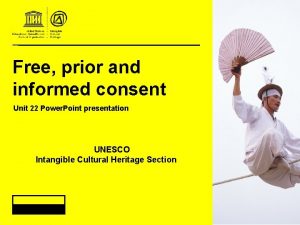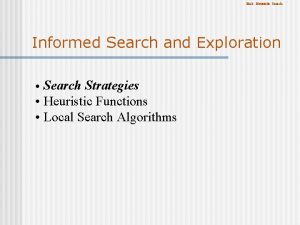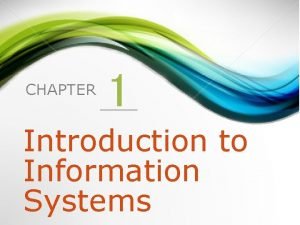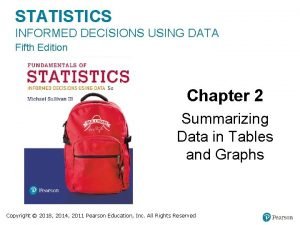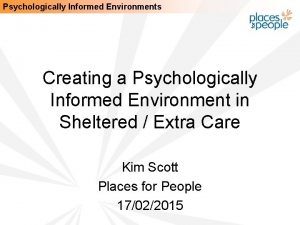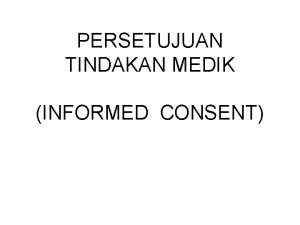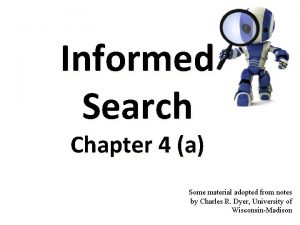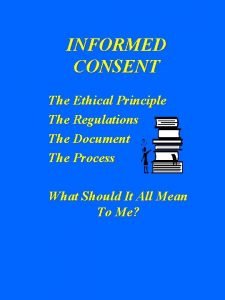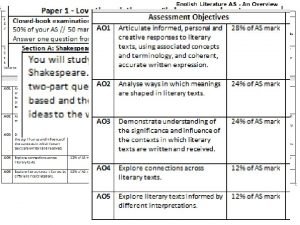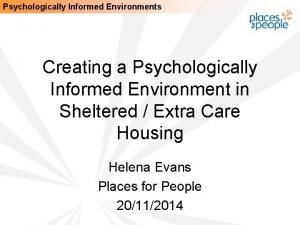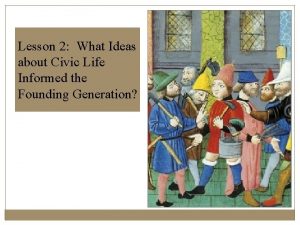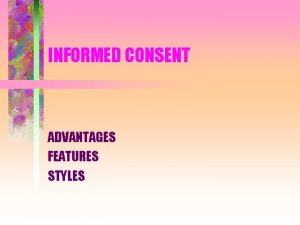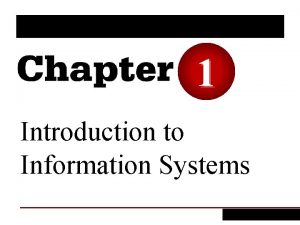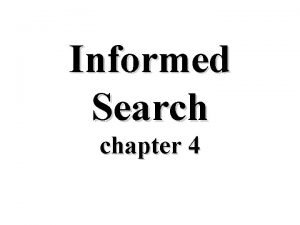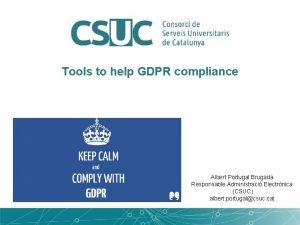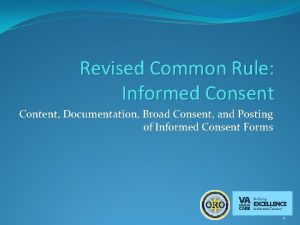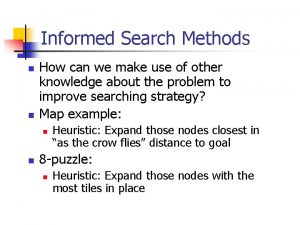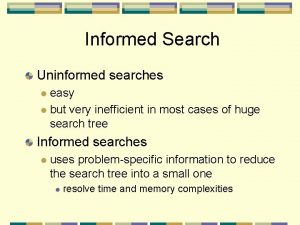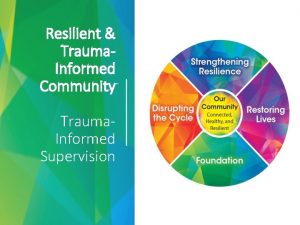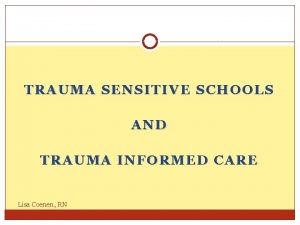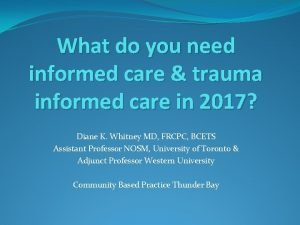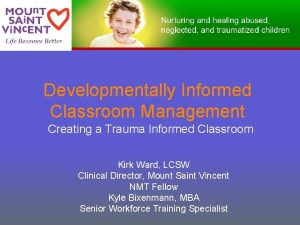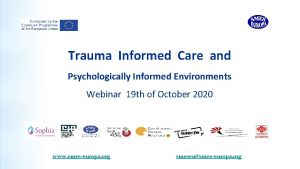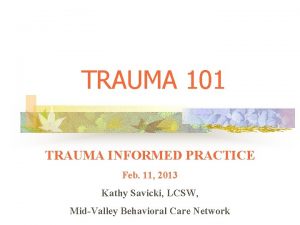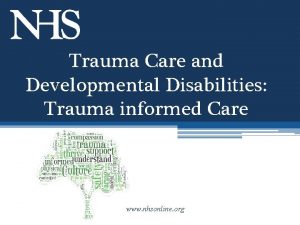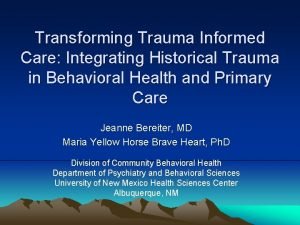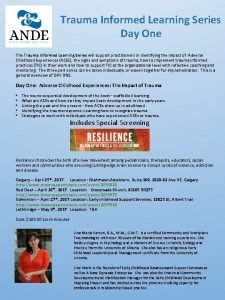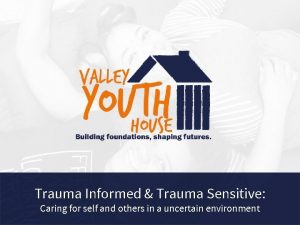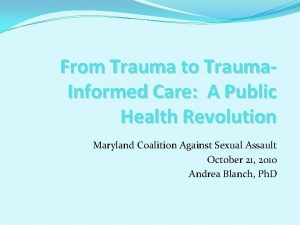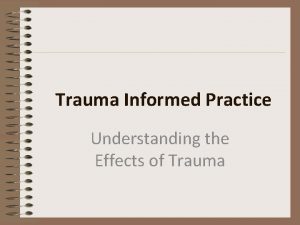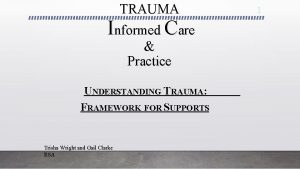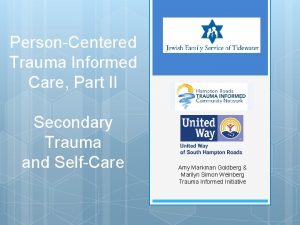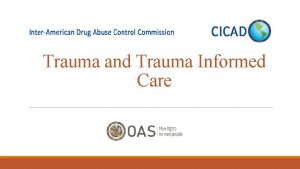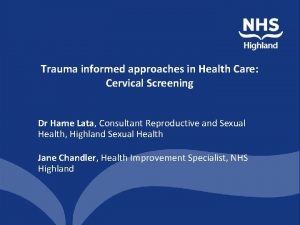An introduction to trauma informed approaches in schools





















































- Slides: 53

An introduction to… trauma informed approaches in schools Elizabeth Garret Anderson School Matthew Blood (Islington Virtual School Head)

Aims A shared understanding of complex trauma and how this impacts on children’s development and learning Consider how complex trauma affects children in school and how we can best support children To exploring trauma-informed approaches to support behaviour and learning

First rule - be aware of and attend to our own feelings if we want to be effective with children This topic can feel difficult at times Looking after ourselves If people are sharing experiences we will listen, be respectful and keep it in the room Where is my energy at? About to blow – can’t think at all Unsettled/ distracted Calm/ focused/ ready to learn (Just Right) Cool and switched off

What are we aiming for in our work with children? What is the fruit that we are hoping to see in the children we work with or what hopes do we have for them on reaching adulthood? – eg. wellbeing/ achievements/ relationships? What does the child need to be able to do to achieve these goals/ outcomes? fruit/ leaves trunk and branches Child: seed of potential What does the child need to believe about himself/ herself to develop these skills? And what kind of approach to threat/ challenge does he / she need to have? What kind of care does the child need in order to develop these beliefs and ways of responding? root system soil

Why it matters , y r o m e m , n i a r b , y d. o r b u o s i ’ v d l a i h h e c b a d n n o a s g t c n i a n p r a m i e l a , s m p i u h a s e Tr n w o i t d l a i l h e r c , a s n n o o i t a s i m h t u emo a r t d f o o o t t s c r a e p d m n i u s e i h t m t g u n i o e b a b g d l i n i h n c r s l a a i e f p l o u p e By c d n n a a h f c f a e t s h t r e o f c s u s d e r re t s s e c u d e r n r in tu

One in four children will have experienced developmental trauma: affecting their behaviour and ability to learn

damage What does the word suffering trauma make you think of? ordeal shock

“A psychologically distressing event (s) that is outside the usual range of human experience often involving a sense of intense fear, terror and helplessness” (Perry 2011) Any experience that threatens life or physical integrity and overwhelms an individual’s capacity to cope: Perception is more important than reality Can be an acute (one off) event or chronic (over time) Trauma is not the event itself, but rather a response to a highly stressful experience in which a person’s ability to cope is dramatically undermined.

c a m u a r t x e l p om

What is complex trauma? Complex trauma is a response to overwhelming negative life events and experiences which happen to children over time, often within their families and personal relationships. If there is no safe adult to help a child process what is happening the experience is more likely to have a traumatic effect.

Adverse Childhood Experiences increase children’s exposure to trauma



How childhood trauma affects health across a lifetime. The ACE study Nadine Burke Harris 5: 38 – 9: 30 https: //youtu. be/95 ov. IJ 3 ds. Nk? t=338

How does complex trauma affect a child’s development, learning and behaviour?

How a child's brain develops through early experiences https: //www. youtube. com/watch? v=h. My. DFYSk. ZSU

The Brain 3 parts: evolved responding to evolutionary need Thinking (Neocortex) Newest SLOWEST Cerebral cortex, forebrain Seat of reason Emotional (Limbic system) Set of emotions Base (Reptilian brain) Hindbrain Oldest FASTEST Brain stem, physical survival, breathing, excretion, blood flow, temperature, other autonomic functions




TRAUMA IN THE BODY Complex trauma often has multi-sensory impact, especially if trauma occurs in the pre-verbal years when memories will be held in the body and the limbic system of the brain, not the conscious part. When the amygdala is having a sense memory, it won’t let the conscious part of the brain know – so the trauma-trigger will be outside of conscious awareness. The intensity of a child’s distress can be an indicator that the distress is trauma related.

What helps the child to survive? The brain adapts and uses a fight/ flight/ freeze/ flop response at times when there appears to be no need - these responses can look like behaviour problems in school Survival trumps everything Assumption of danger - it is about ‘felt safety’ not necessarily actual safety Response in the face of perceived threat – fight, flight or freeze Development of alternative strategies to meet developmental needs – ‘how have these young people learn to get by? ’ e. g. controlling, provoking expected response/seeking out conflict, avoiding help -seeking, unhelpful attempts to self-sooth, dissociation, sensation seeking etc Many distressing behaviours represent the child’s attempt to cope

We all define danger differently Our individual filters – based on experience - guide our interpretation of the world.

There are only a few possible responses to danger: fight, flight, freeze/flop ALL of them REQUIRE a surge of arousal.

Behaviour is generally functional and makes sense in the context it which it developed - but may not in other contexts/ relationships

https: //www. youtube. com/watch? v=Koqa. UANGvp. A

Our ability to shift from “Survival Mode” (survival-based behaviors) to active engagement (learning brain) is impacted by our internal and external resources Affect management Trust Frustration tolerance Ability to read others Problem-solving ability Social connection and support Biological vulnerabilities

Trauma’s dual influence on development 1. Prioritization of those domains of skill / competency / adaptation which help the child survive their environment and meet physical, emotional, and relational needs 2. De-emphasis of domains of development which are less immediately relevant to survival

While children are getting really good at survival, what are they not getting?

Children often have trouble with relationships, boundaries, empathy and social isolation Living in survival mode over a period of time means that. . . Physical health and development is impaired – sensorimotor/ coordination/ medical/ somatic When triggered, the “feeling” brain dominates the “thinking” brain so children struggle to identify and label feelings and communicate their needs

Dissociation: a child may experience amnesia and impaired memory Cognitive ability may be delayed – eg. problems with focus, processing new information, language development, planning and problem-solving and. . . Children can struggle with self concept, body image, low self-esteem, shame and guilt Behavioural control can be an issue – difficulty controlling impulses, oppositional behaviour, aggression, disrupted sleep and eating patterns, trauma re-enactment


Loss of control Feelings of vulnerability or rejection Common triggers for traumatised children loneliness Confrontation, authority or limit setting Sensory overload (too much stimulation from the environment)

Tr n i s r e igg s a l c e th ? m o o r s

Traumatised children may: Expect to be hurt or rejected Have bodies that feel out of control Have feelings too overwhelming to manage Lack age-appropriate coping strategies Lose access to higher cognitive functions when upset Shift moods and states frequently, and have behaviors that feel confusing.

Teaching children how the brain works at times of stress Daniel Siegel Hand Model – “Flipping your lid” https: //www. youtube. com/watch? v=q. FTlj. Lo 1 b. K 8 https: //youtu. be/a_h. Pelc. PRTg? t=38

Physical and emotional distress looks like: Poor control of emotions Shutting down Unpredictable / impulsive behaviour Difficulty controlling behaviour Over/under-reacting to stimuli (bells, touch, looks, sudden movements, lighting…) Resisting or significantly unsettled by transition and/or change Poor attention, memory, cognition, problem solving, planning Reduced ability to focus, organise, process information Overwhelming feelings of frustration or anxiety


Break

Trauma informed approaches in school üUses the recognition that certain behaviours are related to traumatic experience to drive a new set of practices at school with pupils who exhibit these behaviours. üShifts from a model that asks, “What is wrong with you? ” to one that asks, “What happened to you? ” üA new question emerges: “How can we shift the school environment and classroom practices to respond more effectively to your needs


The benefits of being trauma informed… üImproved achievement üReduction in exclusions, detentions, referrals üConsistent approach to dealing with behaviour üCalm adult behaviour leading to less stress for staff (and pupils) üPupils more valued and ready to learn


Essentials… there is no more effective neurobiological intervention that a safe relationship” “ Bruce Perry, researcher and child psychiatrist The relationship works to bring the brain back into regulation Safe, predictable and consistent relationships… Traumatized learners follow calm and consistent adults rather than rules

Key elements of trauma informed approach include… § A whole school approach. A child, in order to feel safe at school, needs to know that they can approach any member of staff and receive the same response § Behaviour as a symptom of the problem, not the problem. This is not to say that violence or breaches of safety do not incur serious consequences, but that the consequences include a depth of investigation and a great deal of support

Commitment to building trust and relationships day by day. For pupils and families living trauma, each day can bring a new struggle, and school can provide a sanctuary Assuming complexity, approaching with empathy and curiosity Support children to build the skills that are a struggle for them, and include them in the process Connecting with the whole family Connection with external agencies, because school can’t do it all

Interventions and strategies § Empathetic engagement, the pupil’s emotional state is acknowledged and validated, promoting a sense of security and feeling 'felt' § Visual reminders of the day, for the whole class and individuals § Consistent routines and a language of expectation and support § Model and teach the behaviour you want to see, e. g. meet and greet. Persistently catch pupils doing the right thing… § A trusted adult and co-regulator in school

§ Clear and open communication between teachers, particularly at transition times, know who the most vulnerable are § Positive reinforcement, a ratio of 6: 1 positive to corrective feedback § Calming activities, especially when pupils are heightened (after break times) § Allowing self-regulation and co-regulation outside the classroom. A safe space § Sensory input opportunities

§ Big learning expectations that last only a small, achievable amount of time § Pre-emptive strikes. some pupils need important ‘jobs’ for the five minutes between activities, so they are able to enter an already calm room, reducing the chance they will become heightened by the change § Opportunities to make choices, to practice identifying preferences and interests § Recognition boards /word walls, lots of visual exposure to words that pupils might want to use

Intervention and recovery… Conversations with traumatized learners… interrupting thought patterns and calming situations before they escalate § Gentle, personal, non threatening, side on, eye level or lower. Don’t demand eye contact. Not over emotional – avoid power play § Name the emotion – “I can see/understand that you are angry” § Remind of previous good behaviour § Challenge their negative perception “ you can do this…” § Walk away, allow time for the pupil to decide what to do next. “I am going to walk away and give you chance to think about what happened. I know when I come back we can have polite and productive talk.

Recovery conversations… A repair or reparation conversation should be short, private and should be done by the adult involved in the incident. The meeting is discuss the incident not the pupils character. It needs to be structured and planned. A stepped approach can help ØWhat happened? ØWhat were you thinking at the time? ØWhat have you thought since? ØHow did this make you/others feel? ØHow should we put things right?

Can it work? https: //www. youtube. com/watch? v=u. Mbh. B 2 l 4 ut 0 https: //www. youtube. com/watch? v=vy. Qd. OLl 6 d 2 c

Workshops….
 4 r's trauma informed care
4 r's trauma informed care Trauma informed care lgbtq
Trauma informed care lgbtq Anita ravi md
Anita ravi md 4 r's trauma informed care
4 r's trauma informed care Trauma informed icebreakers
Trauma informed icebreakers Trauma-informed workplace checklist
Trauma-informed workplace checklist Trauma-informed questions for clients
Trauma-informed questions for clients 4 r's trauma informed care
4 r's trauma informed care Trauma informed legal advocacy
Trauma informed legal advocacy Kobtion
Kobtion Libby bergman
Libby bergman Tina champagne trauma informed care
Tina champagne trauma informed care Trauma informed advising
Trauma informed advising Acessexual
Acessexual Trauma informed practice
Trauma informed practice Trauma infromed
Trauma infromed Trauma informed practice
Trauma informed practice Trauma informed practice
Trauma informed practice Trauma informed care for foster youth
Trauma informed care for foster youth Huntsville.powerschool.com
Huntsville.powerschool.com Reach safety schools
Reach safety schools Informed action meaning
Informed action meaning Stakeholders mapping
Stakeholders mapping Psychologically informed environment
Psychologically informed environment Stakeholder matrix
Stakeholder matrix 22power dot com
22power dot com Informed (heuristic) search strategies
Informed (heuristic) search strategies An informed guess or assumption about a certain problem
An informed guess or assumption about a certain problem Informed search and uninformed search in ai
Informed search and uninformed search in ai You should seek to be an informed user of it because
You should seek to be an informed user of it because Statistics informed decisions using data 5th edition pdf
Statistics informed decisions using data 5th edition pdf Psychologically informed environments
Psychologically informed environments Psychologically informed environments
Psychologically informed environments Sebutkan dasar hukum informed consent
Sebutkan dasar hukum informed consent Informed search example
Informed search example Best first search in ai
Best first search in ai Usps informed consent
Usps informed consent Post campaign analysis presentation
Post campaign analysis presentation Ethical principles governing informed consent process
Ethical principles governing informed consent process Blind search algorithm
Blind search algorithm Informed personal response
Informed personal response Psychologically informed environment
Psychologically informed environment What philosophical ideas informed the founding generation?
What philosophical ideas informed the founding generation? Informed delivery campaigns
Informed delivery campaigns Advantages of informed consent
Advantages of informed consent Is a consultative function of the mis department.
Is a consultative function of the mis department. Decision making skills
Decision making skills Examples of informed search
Examples of informed search Informed search
Informed search Slbet portugal
Slbet portugal Broad informed consent
Broad informed consent Greedy search
Greedy search Informed consent brochure
Informed consent brochure Informed and uninformed search
Informed and uninformed search
